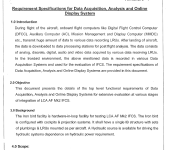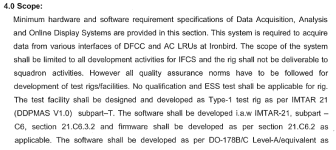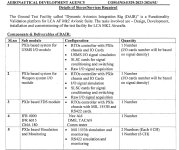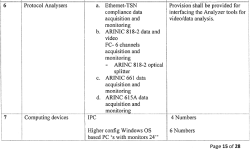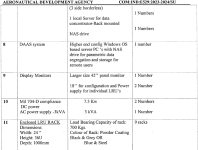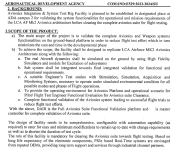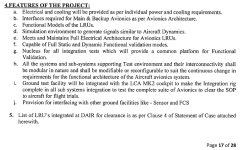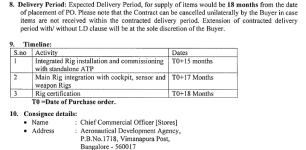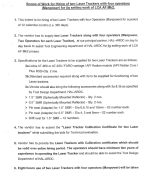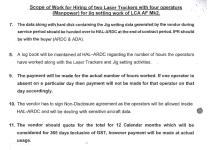Haven't you realised yet that the LCA MK2 is a magicraft?That fellow didn't get the sarcasm.
LCA AF Mk2 (Medium Weight Fighter) - News and discussions
- Thread starter Schwifty
- Start date
You are using an out of date browser. It may not display this or other websites correctly.
You should upgrade or use an alternative browser.
You should upgrade or use an alternative browser.
AFAIK its just a blueprint as of now. Even HAL is promising 29-30 time frame for delivery, and not even god can predict HAL's timeli with atmost accuracy. So post 2030, even Rafake F3r won't be a silver bullet. And you are expecting mk2 to be magicraft which wont have a spectra type EW suit or a radar with anti jamming capabilities.Haven't you realised yet that the LCA MK2 is a magicraft?
This fellow didn't get the sarcasmAFAIK its just a blueprint as of now. Even HAL is promising 29-30 time frame for delivery, and not even god can predict HAL's timeli with atmost accuracy. So post 2030, even Rafake F3r won't be a silver bullet. And you are expecting mk2 to be magicraft which wont have a spectra type EW suit or a radar with anti jamming capabilities.

Anyways, seriously:
1. MK2 will have SPECTRA type integrated EW suite.
2. It'll have GaN AESA radar with EA capability.
It isn't supposed to be silver bullet but rather IAF's workhorse. AMCA MK2 would be that for us along with FUFA/Ghatak.
No, you'd need a magiware for that, and it's not that easy to get - even the US can't do it.1. MK2 will have SPECTRA type integrated EW suite.
Pls provide what made you to think that nk2 will have spectra type EW & radar with EA capability will be incorporated in mk2?This fellow didn't get the sarcasm
Anyways, seriously:
1. MK2 will have SPECTRA type integrated EW suite.
2. It'll have GaN AESA radar with EA capability.
It isn't supposed to be silver bullet but rather IAF's workhorse. AMCA MK2 would be that for us along with FUFA/Ghatak.
Our scientists fully understand how SPECTRA works. Our solution will not be any less worse.No, you'd need a magiware for that, and it's not that easy to get - even the US can't do it.
By SPECTRA type EW, I mean it'll have fully internal Unified Electronic Warfare Suite that will do ECM/ESM/Geo-location just like the above.Pls provide what made you to think that nk2 will have spectra type EW & radar with EA capability will be incorporated in mk2?
Most AESA radars are fully capable of EA. F-35's APG-81/Barracuda combo jammed APG-77 of Raptor. Tejas MK2 will have GaN based AESA radar which will be a generation more advance than APG-81. So, in-built EW/EA function is a given.
Do you have any authentic reports for both the cases?By SPECTRA type EW, I mean it'll have fully internal Unified Electronic Warfare Suite that will do ECM/ESM/Geo-location just like the above.
Most AESA radars are fully capable of EA. F-35's APG-81/Barracuda combo jammed APG-77 of Raptor. Tejas MK2 will have GaN based AESA radar which will be a generation more advance than APG-81. So, in-built EW/EA function is a given.
Do you have any authentic reports for both the cases?

This image is only for representation, but this is what is planned. You can see that even the transmitters are integrated into the airframe and not podded like that of MKI/MK1A.
Source of the image and a great read on EW: Electronic Warfare -Trends – Time For India to Become Atamnirbhar
^^ in this regard, the test rig for LCA mk2 radar mentioned this , as we knew already. So all these are going to be part of the system likely from the beginning. @Rajput Lion


ps: there are few more info but can not be posted in open.




ps: there are few more info but can not be posted in open.


HAL is looking to roll out 1st LCA MK-2 by March 2026.
Part 3: The Tejas Mark 2: Incremental development
The order book of Hindustan Aeronautics Ltd (HAL) remains the envy of India’s defence industry, standing at Rs 94,000 crore at the end of the Financial Year 2023-24. That is more than three times the company’s turnover of Rs 29,810 crore last year.
The order book includes 83 Tejas Mark 1A fighters, contracted with the Indian Air Force (IAF) for Rs 48,000 crore. However, it does not include the acquisition of 97 more Tejas Mark 1A, for an estimated Rs 65,000 crore, which the Ministry of Defence (MoD) announced in April.
It also leaves out the procurement of 150-200 Tejas Mark 2 fighters – a larger, better armed and more sophisticated version of the Tejas Mark 1A fighter – that is being developed by HAL and the Defence R&D Organisation (DRDO).
HAL officials told Business Standard during a visit to Bengaluru last month that they expect the Indian Air Force (IAF) to procure 100-150 Tejas Mark 2 fighters.
The Tejas Mark 2 was conceived as a marginal improvement on the Tejas light combat aircraft (LCA). It has now evolved into a significantly larger and more capable fighter.
This change comes from replacing the Tejas Mark 1’s General Electric F-404 power pack with GE’s muscular F-414 engine. While the F-404’s peak thrust is just 83 KiloNewtons, the F-414 delivers a blazing 98 kiloNewtons of thrust on full afterburners.
This power increment enables the Mark 2 to get aloft with an all-up weight of 16.5 tonnes, including the 10-tonne weight of the fighter and 6.5 tonnes of external payload. This easily outperforms the Mark 1, which has an external payload limit of just 3.5 per tonnes.
The Tejas Mark 2’s increased payload gives mission planners many more options. For air-to-air combat, the Mark 2 will carry the indigenous Astra Mark 1 and Mark 2 missiles; wingtip-mounted ASRAAM missiles and the DRDO’s RudraM (yes, that’s the spelling) anti-radiation missiles.
The DRDO is also developing a range of bombs for the Tejas Mark 2. The Tara high speed, low drag, glide bomb is mounted on the pylons; along with laser guided bombs (LGBs) with laser-guidance kits. The SCALP missile, procured from European manufacturer MBDA, along with the Rafale fighters, will also be integrated with the Tejas Mark 2.
To carry this payload, the Tejas Mark 2 will have 11 hard points, including one on each wingtip for the ASRAAM advanced short-range air-to-air missile. There will be three under-wing pylons on each side, one wet station on each side for fuel drop tanks, while the other three hard points are for long-range missiles such as the Astra and the RudraM, which the DRDO successfully tested on Wednesday.
“The fighter’s Preliminary Design Review (PDR) was completed in December 2023 and the design has been frozen. The manufacture of parts has begun and we expect the first Tejas Mark 2 prototype to be ready by June 2026,” said CB Ananthakrishnan, HAL’s chairman and managing director (CMD) to Business Standard.
“The Mark 2 prototype will be ready by June 2026. After that, it will take about two years of flight testing to certify the various systems. By June 2029, we should start delivering the production aircraft,” he said.
The Mark 2 fleet would require at least five years to build, starting from 2029-30. The numbers would initially be very small, but from 2030-31 they would again pick up, because the LCA Mark 2 would again get over. So the five years would end by about 2035-36.
PDR is the process of determining the degree to which the aircraft’s design complies with the air staff qualitative requirements (ASQRs) and determining that the aircraft meets those requirements.
This is followed by the Critical Design Review (CDR), which ensures translation of the preliminary design into a detailed design.
“In the Tejas Mark 2, we have gone far beyond the PDR and begun building the aircraft. The design phase has almost been completed, except for some small changes that may be required,” said Ananthakrishnan.
A key challenge in developing the Mark 2 fighter is increasing the capacity of its mission computer and flight software. A new mission computer has been developed and integrated into a Tejas Mark 1A for testing.
Mission computers are the heart of the aircraft, driving its displays, sensors, etc. However, the critical aspects of control over the Tejas Mark 2’s flight – such as its quadruplex, fly-by-wire flight software – are controlled by its Digital Flight Control Computer.
In developing this software, India has taken on, and won, the central challenge of designing and developing its own fighter aircraft.
================================
Timeline: Tejas Mark 2 development
Preliminary Design Review : December 2023
First Mark 2 prototype build : June 2026
Flight testing (two years) : June 2028
Delivery begins of production aircraft : June 2029
Building of Tejas Mark 2 fleet (5 years) : 2035-36
The order book of Hindustan Aeronautics Ltd (HAL) remains the envy of India’s defence industry, standing at Rs 94,000 crore at the end of the Financial Year 2023-24. That is more than three times the company’s turnover of Rs 29,810 crore last year.
The order book includes 83 Tejas Mark 1A fighters, contracted with the Indian Air Force (IAF) for Rs 48,000 crore. However, it does not include the acquisition of 97 more Tejas Mark 1A, for an estimated Rs 65,000 crore, which the Ministry of Defence (MoD) announced in April.
It also leaves out the procurement of 150-200 Tejas Mark 2 fighters – a larger, better armed and more sophisticated version of the Tejas Mark 1A fighter – that is being developed by HAL and the Defence R&D Organisation (DRDO).
HAL officials told Business Standard during a visit to Bengaluru last month that they expect the Indian Air Force (IAF) to procure 100-150 Tejas Mark 2 fighters.
The Tejas Mark 2 was conceived as a marginal improvement on the Tejas light combat aircraft (LCA). It has now evolved into a significantly larger and more capable fighter.
This change comes from replacing the Tejas Mark 1’s General Electric F-404 power pack with GE’s muscular F-414 engine. While the F-404’s peak thrust is just 83 KiloNewtons, the F-414 delivers a blazing 98 kiloNewtons of thrust on full afterburners.
This power increment enables the Mark 2 to get aloft with an all-up weight of 16.5 tonnes, including the 10-tonne weight of the fighter and 6.5 tonnes of external payload. This easily outperforms the Mark 1, which has an external payload limit of just 3.5 per tonnes.
The Tejas Mark 2’s increased payload gives mission planners many more options. For air-to-air combat, the Mark 2 will carry the indigenous Astra Mark 1 and Mark 2 missiles; wingtip-mounted ASRAAM missiles and the DRDO’s RudraM (yes, that’s the spelling) anti-radiation missiles.
The DRDO is also developing a range of bombs for the Tejas Mark 2. The Tara high speed, low drag, glide bomb is mounted on the pylons; along with laser guided bombs (LGBs) with laser-guidance kits. The SCALP missile, procured from European manufacturer MBDA, along with the Rafale fighters, will also be integrated with the Tejas Mark 2.
To carry this payload, the Tejas Mark 2 will have 11 hard points, including one on each wingtip for the ASRAAM advanced short-range air-to-air missile. There will be three under-wing pylons on each side, one wet station on each side for fuel drop tanks, while the other three hard points are for long-range missiles such as the Astra and the RudraM, which the DRDO successfully tested on Wednesday.
“The fighter’s Preliminary Design Review (PDR) was completed in December 2023 and the design has been frozen. The manufacture of parts has begun and we expect the first Tejas Mark 2 prototype to be ready by June 2026,” said CB Ananthakrishnan, HAL’s chairman and managing director (CMD) to Business Standard.
“The Mark 2 prototype will be ready by June 2026. After that, it will take about two years of flight testing to certify the various systems. By June 2029, we should start delivering the production aircraft,” he said.
The Mark 2 fleet would require at least five years to build, starting from 2029-30. The numbers would initially be very small, but from 2030-31 they would again pick up, because the LCA Mark 2 would again get over. So the five years would end by about 2035-36.
PDR is the process of determining the degree to which the aircraft’s design complies with the air staff qualitative requirements (ASQRs) and determining that the aircraft meets those requirements.
This is followed by the Critical Design Review (CDR), which ensures translation of the preliminary design into a detailed design.
“In the Tejas Mark 2, we have gone far beyond the PDR and begun building the aircraft. The design phase has almost been completed, except for some small changes that may be required,” said Ananthakrishnan.
A key challenge in developing the Mark 2 fighter is increasing the capacity of its mission computer and flight software. A new mission computer has been developed and integrated into a Tejas Mark 1A for testing.
Mission computers are the heart of the aircraft, driving its displays, sensors, etc. However, the critical aspects of control over the Tejas Mark 2’s flight – such as its quadruplex, fly-by-wire flight software – are controlled by its Digital Flight Control Computer.
In developing this software, India has taken on, and won, the central challenge of designing and developing its own fighter aircraft.
================================
Timeline: Tejas Mark 2 development
Preliminary Design Review : December 2023
First Mark 2 prototype build : June 2026
Flight testing (two years) : June 2028
Delivery begins of production aircraft : June 2029
Building of Tejas Mark 2 fleet (5 years) : 2035-36
With 11 hard-points MK2 would carry plenty of BVR missiles for total air-dominance and pack quite a decent punch. Like it




